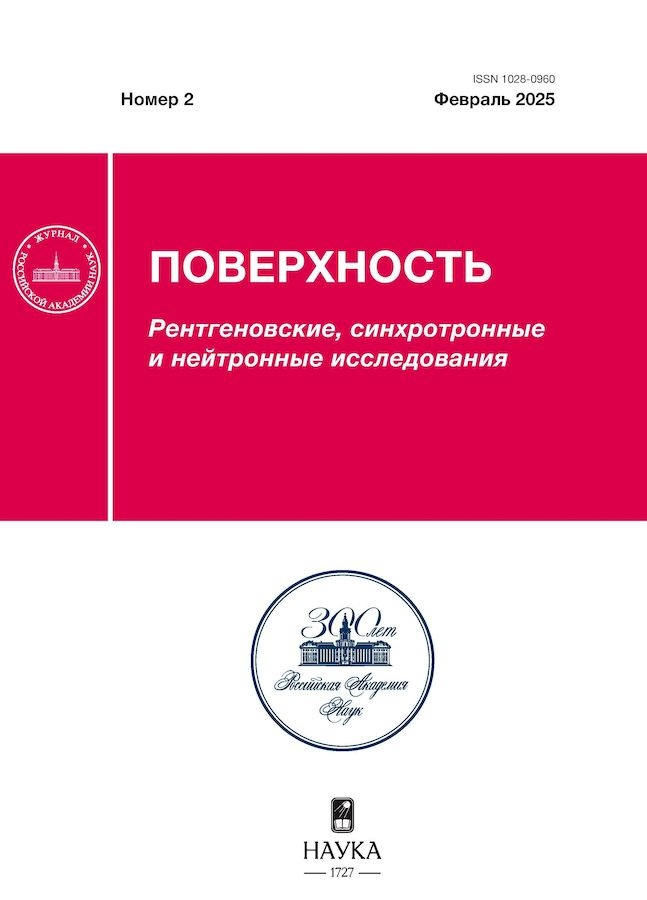The Impact of Thermal Treatment on the Properties of Polymer-Contained Composite Films of CsPbBr2I
- Авторлар: Toikka A.S.1,2, Kenesbay R.1, Baeva M.1, Mitin D.M.1, Mukhin I.S.1
-
Мекемелер:
- Alferov Saint Petersburg University of the Russian Academy of Sciences
- ITMO University
- Шығарылым: № 2 (2025)
- Беттер: 12-15
- Бөлім: Articles
- URL: https://vestnik-pp.samgtu.ru/1028-0960/article/view/686768
- DOI: https://doi.org/10.31857/S1028096025020025
- EDN: https://elibrary.ru/EHBDCU
- ID: 686768
Дәйексөз келтіру
Аннотация
In the current work, the impact of vacuuming and annealing temperatures on the properties of composite films based on CsPbBr2I perovskites with partial substitution of Pb2+ ions for Mn2+ and passivation of grain boundaries with polyethylene oxide and polyvinylidene fluoride were used. Dimethyl sulfoxide was used as a solvent. The spin-coating method was used to form films. The vacuuming and annealing temperatures varied in the ranges of 60–80°C and 60–90°C respectively. The spectral dependences of photoluminescence were compared in the investigation. Based on it, the conclusions about the influence of phase segregation and the applicability of the temperature regime were made. It was found that samples obtained using vacuuming and annealing temperatures of 70 °C exhibited photoluminescence peaks of 616 ± 14 nm and 638 ± 18 nm. The presence of two peaks indicates minor phase segregation, which manifests itself in a local change in the stoichiometric composition of the samples with the formation of regions enriched with bromine and iodine However, among the sample under study, taking into account the limitation of photoinduced phase segregation, the specified thermal regime is optimal: a decrease in temperature leads to a shift of the photoluminescence peak to the green region of the spectrum, while its increase leads to the formation of defective non-luminescent phases.
Толық мәтін
Авторлар туралы
A. Toikka
Alferov Saint Petersburg University of the Russian Academy of Sciences; ITMO University
Хат алмасуға жауапты Автор.
Email: astoikka.nano@gmail.com
Ресей, Saint Petersburg; Saint Petersburg
R. Kenesbay
Alferov Saint Petersburg University of the Russian Academy of Sciences
Email: astoikka.nano@gmail.com
Ресей, Saint Petersburg
M. Baeva
Alferov Saint Petersburg University of the Russian Academy of Sciences
Email: astoikka.nano@gmail.com
Ресей, Saint Petersburg
D. Mitin
Alferov Saint Petersburg University of the Russian Academy of Sciences
Email: astoikka.nano@gmail.com
Ресей, Saint Petersburg
I. Mukhin
Alferov Saint Petersburg University of the Russian Academy of Sciences
Email: astoikka.nano@gmail.com
Ресей, Saint Petersburg
Әдебиет тізімі
- Yao Z., Zhao W., Chen S., Jin Z., Liu, S. F. // ACS Appl. Energy Mater. 2020. V. 3. № 6. P. 5190. https://www.doi.org/10.1021/acsaem.9b02468
- Wang Q., Gong Z., Wu S., Pan S., Pan J. // J. Crystal Growth. 2022. № 596. P. 126838. https://www.doi.org/org/10.1016/j.jcrysgro.2022. 126838
- Zhang X., Yang P. // Langmuir. 2023. V. 39. № 32. P. 11188. https://www.doi.org/10.1021/acs.langmuir.3c01848
- Moon J., Mehta Y., Gundogdu K., So F., Gu Q. // Adv. Mater. 2023. P. 2211284. https://www.doi.org/10.1002/adma.202211284
- Baeva M., Gets D., Polushkin A., Vorobyov A., Goltaev A., Neplokh V., Mozharov A., Krasnikov D.V., Nasibulin A.G., Mukhin I., Makarov S. // Opto-Electronic Adv. 2023. V. 6. P. 220154. https://www.doi.org/10.29026/oea.2023.220154
- Hänsch P., Loi M.A. // Appl. Phys. Lett. 2023. V. 123. P. 030501. https://www.doi.org/10.1063/5.0151942
- Li H., Lin H., Ouyang D., Yao C., Li C., Sun J., Song Y., Wang Y., Yan Y., Wang Y., Dong Q., Choy W.C.H. // Adv. Mater. 2021. V. 33. P. 2008820. https://www.doi.org/10.1002/adma.202008820
- Shen X., Zhang X., Wang Z., Gao X., Wang Y., Lu P., Bai X., Hu J., Shi Z., Yu W.W., Zhang Y. // Adv. Functional Mater. 2022. V. 32. P. 2110048. https://www.doi.org/10.1002/adfm.202110048
- Yang J.N., Song Y., Yao J.S., Wang K.H., Wang J.J., Zhu B.S., Yao M.M., Rahman S.U., Lan Y.F., Fan F.J., Yao H. // J. Am. Chem. Soc. 2020. V. 142. № 6. P. 2956. https://www.doi.org/10.1021/jacs.9b11719
- Aygüler M.F., Puscher B.M.D., Tong Y., Bein T., Urban A.S., Costa R.D., Docampo P. // J. Phys. D: Appl. Phys. 2018. V. 51. № 33. P. 1. https://www.doi.org/10.1088/1361-6463/aad203
- Wang C.M., Su Y.M., Shih T.A., Chen G.Y., Chen Y.Z., Lu C.W., Yu I.S., Yang Z.P., Su H.C. // J. Mater. Chem. C. 2018. V. 6. № 47. P. 12808. https://www.doi.org/10.1039/c8tc04451a
- Stockman A., Macleod D.I.A., Johnson N.E. // J. Opt. Soc. Am. A. 1993. V. 10. № 12. P. 2491. https://www.doi.org/10.1364/josaa.10.002491
- Li J., Yang L., Guo Q., Du P., Wang L., Zhao X., Liu N., Yang X., Luo J., Tang J. // Sci. Bull. 2022. V. 67. № 2. P. 178. https://www.doi.org/10.1016/j.scib.2021.09.003
- Liang J., Liu Z., Qiu L., Hawash Z., Meng L., Wu Z., Jiang Y., Ono L.K., Qi Y. // Adv. Energy Mater. 2018. V. 8. P. 1800504. https://www.doi.org/10.1002/aenm.201800504
- Zheng L., Hurst T., Li Z. // Georgia J. Sci. 2022. V. 80. № 2. P. 1.
- Gets D., Alahbakhshi M., Mishra A., Haroldson R., Papadimitratos A., Ishteev A., Saranin D., Anoshkin S., Pushkarev A., Danilovskiy E., Makarov S., Slinker J.D., Zakhidov A.A. // Adv. Opt. Mater. 2021. V. 9. P. 2001715. https://www.doi.org/10.1002/adom.202001715
- Mondal S., Paul T., Maiti S., Das B.K., Chattopadhyay K.K. // Nano Energy. 2020. V. 74. P. 104870. https://www.doi.org/10.1016/j.nanoen.2020.104870
- Liu C., Cheng Y.B., Ge Z. // Chem. Soc. Rev. 2020. V. 49. № 6. P. 1653. https://www.doi.org/10.1039/c9cs00711c
- Zhang X., Gao X., Meng X. // J. Alloys Compd. 2019. V. 810. P. 151943. https://www.doi.org/10.1016/j.jallcom.2019.151943
- Gualdrón-Reyes A.F., Yoon S.J., Barea E.M., Agouram S., Muñoz-Sanjosé V., Meléndez Á.M., Niño-Gómez M.E., Mora-Seró I. // ACS Energy Lett. 2019. V. 4. № 1. P. 54. https://www.doi.org/10.1021/acsenergylett.8b02207
- OceanView (v. 1.6.7) (2020) Ocean Optics, США. https://www.oceanoptics.com/software/. Дата посещения 16.08.2024.
Қосымша файлдар










